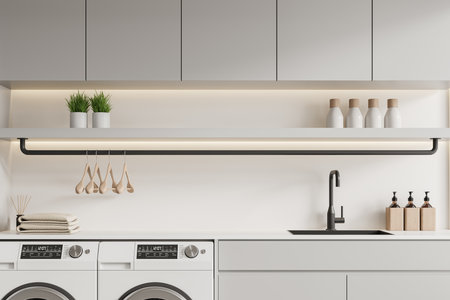Introduction to Open Kitchen Concepts
Open kitchen concepts have become a defining feature of modern home design. Unlike traditional closed kitchens, open kitchens blend seamlessly with living and dining areas, creating a more inclusive and interactive environment. This layout eliminates walls and barriers, making the space feel larger and more connected.
Why Are Open Kitchens Popular?
The rise in popularity of open kitchens can be attributed to several factors. Homeowners appreciate the spacious feel, improved social interactions, and enhanced natural light that this design offers. In modern homes, where maximizing space and functionality is essential, open kitchens provide a practical and stylish solution.
How Open Kitchens Impact Living Spaces
An open kitchen changes the dynamics of a home by fostering a more communal atmosphere. Family members can cook, eat, and entertain guests without feeling isolated. However, this design also introduces challenges such as noise, cooking odors, and limited storage space.
Key Features of Open Kitchen Concepts
| Feature | Description |
|---|---|
| No Walls or Barriers | Creates a seamless connection between kitchen, dining, and living spaces. |
| Improved Natural Light | Lack of walls allows sunlight to flow throughout the home. |
| Better Social Interaction | Makes it easier to engage with family and guests while cooking. |
| Aesthetic Appeal | A modern and minimalist look enhances overall home design. |
2. Benefits of an Open Kitchen Layout
An open kitchen layout has become a popular choice in modern homes, offering several advantages that enhance both functionality and aesthetics. Below are some key benefits of opting for an open kitchen concept.
Increased Social Interaction
One of the biggest advantages of an open kitchen is that it promotes social interaction. Whether youre preparing meals or entertaining guests, an open layout allows you to stay connected with family and friends. This setup eliminates barriers, making conversations easier and more natural.
Better Natural Light Flow
With fewer walls blocking windows, an open kitchen allows for better natural light distribution throughout the space. This not only makes the kitchen feel brighter and more inviting but also helps create a warm and welcoming atmosphere in the entire living area.
Enhanced Aesthetics for Contemporary Homes
An open kitchen seamlessly blends with the rest of the home, creating a sleek and modern look. The absence of walls makes the space feel larger, contributing to a spacious and airy design that suits contemporary home styles.
Key Benefits at a Glance
| Benefit | Description |
|---|---|
| Social Interaction | Easier communication between family members and guests while cooking. |
| Natural Light Flow | No walls blocking sunlight, resulting in a brighter space. |
| Aesthetic Appeal | A seamless, modern design that enhances home interiors. |
A More Functional Living Space
An open kitchen connects seamlessly with dining and living areas, making it easier to multitask. Parents can keep an eye on kids while cooking, and hosts can engage with guests without being confined to a separate room.
![]()
3. Challenges and Drawbacks
While open kitchen concepts offer many benefits, they also come with certain challenges that homeowners should consider. From noise concerns to cooking odors spreading throughout the home, these potential downsides can impact daily living.
Noise Issues
One of the most common complaints about open kitchens is noise. Without walls to contain sounds, everything from clattering dishes to the hum of appliances can be heard throughout the living space. This can be particularly troublesome in households where people work from home or enjoy quiet relaxation.
Cooking Odors Spreading
Another major drawback of open kitchens is that cooking smells can easily travel beyond the kitchen area. While some aromas are pleasant, strong food odors like fried foods or spices can linger in furniture and fabrics, making it difficult to keep the home smelling fresh.
Lack of Storage and Separation
An open kitchen design often means fewer upper cabinets and walls, which can lead to a shortage of storage space for cookware, utensils, and pantry items. Additionally, without a physical separation between the kitchen and living area, keeping clutter out of sight becomes more challenging.
Common Challenges in Open Kitchen Concepts
| Challenge | Description |
|---|---|
| Noise Issues | No barriers to contain sound, making it harder to control noise levels in shared spaces. |
| Cooking Odors | Aromas from food preparation can spread throughout the house and linger in fabrics. |
| Lack of Storage | Fewer cabinets and walls result in limited storage options for kitchen essentials. |
| No Separation | The absence of walls makes it difficult to hide kitchen messes from view. |
4. Design Considerations for Open Kitchens
When planning an open kitchen, several design factors need to be carefully considered to create a functional and visually appealing space. From proper ventilation to smart storage solutions, these elements ensure that your open kitchen integrates seamlessly with the rest of your home.
Ventilation Solutions
One of the biggest challenges of an open kitchen is managing cooking odors and smoke. Without walls to contain them, smells can easily spread throughout the living space. Here are some effective ventilation options:
| Ventilation Option | Benefits |
|---|---|
| Range Hoods | Powerful extraction of smoke and grease, available in ducted or ductless models. |
| Ceiling-Mounted Exhaust Fans | Provides additional air circulation to remove lingering odors. |
| Windows and Cross Ventilation | A natural and cost-effective way to improve airflow. |
Smart Storage Ideas
An open kitchen requires smart storage solutions to keep everything organized and clutter-free. Without upper cabinets acting as dividers, you need creative ways to maximize space while maintaining a sleek look.
- Built-in Shelving: Helps display decorative items while keeping essentials within reach.
- Hidden Storage: Pull-out drawers and concealed compartments make use of every inch of space.
- Multi-Functional Furniture: Kitchen islands with built-in cabinets provide both workspace and storage.
Cohesive Interior Design
An open kitchen should blend seamlessly with the adjoining living or dining areas. To achieve this, consider the following design principles:
Consistent Color Palette
Select colors that complement the overall theme of your home. Neutral tones or matching wood finishes help unify the space.
Smooth Flooring Transitions
If using different flooring materials between the kitchen and living area, ensure a smooth transition to maintain visual harmony.
Pendant lights over the kitchen island can match chandeliers or recessed lighting in adjacent spaces, creating a cohesive look.
A well-designed open kitchen balances functionality with aesthetics, ensuring a comfortable and stylish living environment. By focusing on ventilation, storage, and cohesive design, you can make the most out of your open-concept space.
5. Is an Open Kitchen Right for You?
Deciding whether an open kitchen is the right choice for your home depends on several factors, including your lifestyle, preferences, and overall home layout. While open kitchens offer many advantages, they may not be suitable for everyone. Below, we’ll explore key considerations to help you determine if this concept aligns with your needs.
✔ Lifestyle and Cooking Habits
How you use your kitchen plays a significant role in deciding whether an open layout is a good fit. Consider the following:
| Factor | Best for Open Kitchens? |
|---|---|
| Frequent entertaining and hosting guests | Yes – Allows social interaction while cooking |
| Cooking elaborate meals with strong aromas | No – Smells can spread throughout the living space |
| Needing privacy while preparing food | No – Open kitchens expose everything to view |
| Keeping an eye on kids or family while cooking | Yes – Provides visibility and accessibility |
✔ Home Layout and Space Considerations
Your homes design can impact how well an open kitchen functions. Think about these aspects:
- Existing Floor Plan: Does your home have a natural flow that would accommodate an open kitchen? If your current layout is compartmentalized, major renovations might be needed.
- Storage Needs: Open kitchens often require creative storage solutions since traditional upper cabinets may be limited.
- Noise Management: If you prefer a quiet atmosphere, consider how kitchen sounds (appliances, dishwashing) might affect adjacent spaces.
✔ Aesthetic Preferences
An open kitchen means that everything is visible at all times. Ask yourself:
- Tidiness: Are you comfortable keeping your kitchen clean and organized daily?
- Cohesive Design: Does your kitchen style complement the rest of your living space?
- Aesthetic Appeal: Do you enjoy the modern, airy feel of an open-concept design?
✔ Making the Right Decision
If youre still unsure whether an open kitchen is the right choice, consider a hybrid approach. Partial walls, sliding doors, or breakfast bars can provide some openness while maintaining separation when needed.

